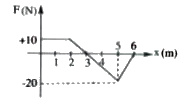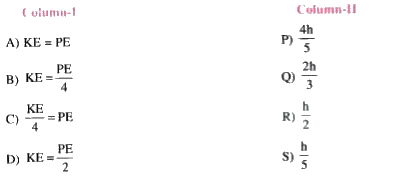A mason worker throws the bricks ot a height of 10m, at which the bricks reach with a velocity of 6ms−1. The percentage of energy he is wasting is nearly (g=10ms−20Solution in Telugu
0.15
0.18
2.2
0.36
The correct Answer is:A
Step by step video, text & image solution for A mason worker throws the bricks ot a height of 10m, at which the bricks reach with a velocity of 6ms^(-1). The percentage of energy he is wasting is nearly (g=10ms^(-2)0 by Physics experts to help you in doubts & scoring excellent marks in Class 11 exams.
Topper's Solved these Questions
- BOOK - AAKASH SERIESCHAPTER - WORK -POWER-ENERGYEXERCISE - PRACTICE SHEET (EXERCISE-V MECHANICAL ENERGY AND ITS CONSERVATION) (LEVEL -II MORE THAN ONE CORRECT ANSWER TYPE QUESTIONS)1videos
WORK -POWER-ENERGY
- BOOK - AAKASH SERIESCHAPTER - WORK -POWER-ENERGYEXERCISE - PRACTICE SHEET (EXERCISE-V MECHANICAL ENERGY AND ITS CONSERVATION) (LEVEL -II MATRIX MATCHING TYPE QUESTIONS)2videos
WORK -POWER-ENERGY
- BOOK - AAKASH SERIESCHAPTER - WORK -POWER-ENERGYEXERCISE - PRACTICE SHEET (EXERCISE-IV POTENTIAL ENERGY) (LEVEL -II INTEGER TYPE QUESTIONS)1videos
WORK -POWER-ENERGY
- BOOK - AAKASH SERIESCHAPTER - VISCOSITY EXERCISE - Questions for Descriptive Answers3videos
VISCOSITY
- BOOK - AAKASH SERIESCHAPTER - WORK POWER ENERGYEXERCISE - EXERCISE - 361videos
WORK POWER ENERGY
Similar Questions
A particle of mass 1 kg moves from test along a straight line by the action of a force F which varies with the distance x as shown in the F-x graph.
 02:02View Solution
02:02View SolutionA body is projected vertically up and h is the maximum height raised by the body compare column-I with column -II in which the height from the ground are given
 02:09View Solution
02:09View SolutionThe potential energy function for a particle executing linear simple harmonic motion is given U(x)=12kx2, where k is the force constant of the oscillator. For k=0.5Nm−1, the graph of U(x) on Y-axis x is shown figure. The particle has total energy 1J. Moving this potential it turns back when it reaches x=±_________m
 02:36View Solution
02:36View SolutionAn iron sphere of mass 20×10−3 kg falls through a viscous liquid with terminal velocity 0.5 m/sec. Find the terminal velocity of another iron sphere of mass 54×10−2 kg.
04:13View SolutionIf →A+→B=→Rand2→A+→B is perpendicular to →B then
05:09View SolutionA wall of length 10 m was to be built across an open ground. The height of the wall is 4 m and thickness of the wall is 24 cm. If this wall is to be built up with bricks whose dimensions are 24cm×12cm×8cm, how
02:53View SolutionA mason constructs a wall of dimensions 5mx40cm xx3m with bricks each 25cm xx10cmx15cm. Calculate the total number of bricks used.
02:51View SolutionHow many bricks required to make 10m long,5m high and 42cm broad.when the dimension of each brick is 42cm xx12cm xx10cm
03:05View SolutionA wall of length 10m was to be build across an open ground. The height of the wall is 4m and thickness of the wall is 24cm. If this wall is to be built up with bricks whose dimensions are 24cm x 12cm x 8cm, how many bricks would be required?
View SolutionA man throws the bricks to a height of 12 m where they reach with a speed of 12 m//s . If he throws the bricks such that they just reach that height, what percentage of energy will be saved? (g = 9.8 m//s^(2))
06:15View SolutionA ball falls on the ground from a height of 10m and rebounds to a height of 8m. What is the percentage loss kinetic energy of the ball? (g=10m/s2)
06:45View SolutionThe minimum and maximum velocities of a projectile are 10ms−1 and 20ms−1 respectively. The horizontal range and maximum height are respectively (g=10 ms−2)
View SolutionA mason worker throws the bricks ot a height of 10m, at which the bricks reach with a velocity of 6ms−1. The percentage of energy he is wasting is nearly (g=10ms−20
View SolutionA mason worker throws the bricks to a height of 10m, at which the bricks reach with a velocity of 6ms−1. The percentage of energy he is wasting is nearly (g=10ms−2)
View SolutionA car moving with a velocity of 72 KMPH stops engine just before ascending an inclined road. If 25% of energy is wasted in overcoming friction, the car rises to a height of (g=10ms−2)
View Solution

